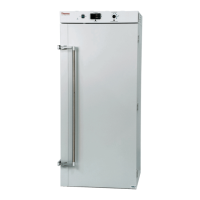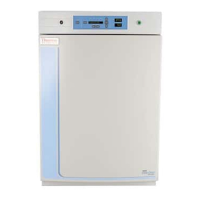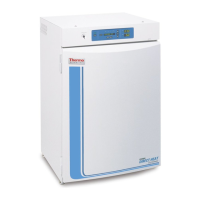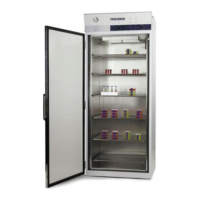Do you have a question about the Thermo Scientific 3950 and is the answer not in the manual?
Provides contact details for Thermo Scientific products and services for pricing, quotations, and support.
Key information to know before contacting for warranty service, including model and serial number location.
Details on specific conditions and services that are not covered by the standard product warranty.
Overview of the control panel components, including keys, displays, and indicators for operation.
Explanation of the four basic modes (Run, Setpoints, Calibration, Configuration) and keypad functions.
Instructions and precautions for properly installing the incubator unit, including placement and clearance.
Steps for initial cleaning and disinfection of the incubator's interior surfaces before use.
Guide on how to install the shelf channels and place shelves at desired levels inside the incubator.
Procedure for ensuring the incubator is level using adjustable feet for stability and proper operation.
Instructions for connecting drain lines for condensate and overflow, if humidity is used.
Recommendations for water purity and type for the humidity reservoir to ensure optimal performance.
Methods for filling the humidity reservoir, including in-house supply, manual, and gravity feed.
Guidance on connecting the incubator to a grounded, dedicated electrical circuit for safe operation.
Instructions for connecting the CO2 gas supply, including regulator requirements and safety warnings.
Steps for initial start-up after installation, including setting basic system parameters.
Procedure to set the desired operating temperature setpoint for the incubator.
Instructions for setting the overtemperature safety setpoint to protect the unit and its contents.
Guidance on setting the desired CO2 concentration setpoint for incubator operation.
Procedure for calibrating the temperature control system using a calibrated reference instrument.
Steps for calibrating the CO2 sensor and control system against a reference instrument.
Instructions on how to disable the ADD WATER alarm if humidity is not required for the application.
Procedure to enable or disable all audible alarms on the incubator's control panel.
How to set a 3-digit access code to prevent unauthorized changes to setpoints or configuration.
Configuring the deviation from the temperature setpoint that triggers a low temperature alarm.
Programming temperature alarms to trigger remote alarm contacts for external monitoring.
Configuring the deviation from the CO2 setpoint that triggers a low CO2 alarm.
Configuring the deviation from the CO2 setpoint that triggers a high CO2 alarm.
Programming CO2 alarms to trigger remote alarm contacts for external monitoring.
Procedure for entering calibration numbers for new CO2 sensors.
Procedure for entering span calibration numbers for new CO2 sensors.
Enabling the feature to achieve relative humidity levels above 90% in the incubator chamber.
Selecting the primary CO2 gas supply tank (Tank 1 or 2) for units with the Gas Guard option.
Instructions to turn the Gas Guard system OFF if it is not in use.
Assigning a unique RS485 address to the incubator for communication with alarm systems.
Information on handling sensor fault alarms, including contact details for technical support.
Condensed list of preventive maintenance requirements for optimal performance and efficiency.
Guidelines for cleaning the chamber interior using disinfectants or alcohol.
Instructions for cleaning the chamber glass door and optional inner doors.
Procedure for periodic cleaning of the humidity reservoir to remove bacteria, fungi, and mineral deposits.
Steps for safely replacing the replaceable fuses in the incubator unit.
Important federal regulations regarding the removal or disposal of incubators from service.
Instructions for connecting to external alarm monitoring systems via relay contacts.
Guidance on connecting the incubator to a Model 1535 alarm system using the RS485 option.
Details on connecting analog output boards for temperature and CO2 signal output.
Information on the built-in Gas Guard system for monitoring and switching CO2 gas supplies.
Instructions for connecting CO2 supply tanks to the incubator's gas guard system.
Procedure to deactivate the Gas Guard system or change the primary tank selection.
Explanation of how the Gas Guard system operates, including alarms and tank switching.
Information on inner doors and shaker support shelves, including cleaning and load limits.
Detailed specifications for temperature control, setpoint, range, uniformity, and tracking alarms.
Information on the type, sensor, and indicators for the incubator's temperature safety system.
Details on the selectable humidity ranges (Medium, High) for the incubator.
Specifications for CO2 control, sensor type, readability, range, and inlet pressure.
Specifications for incubator shelves, interior volume, and construction materials.
Details on incubator fittings (ports, drains) and electrical specifications (power, outlets).
Specifications including BTU output, exterior and interior dimensions, and overall weight.
Information on certifications (UL, CSA, CE) and safety parameters like altitude and pollution degree.
Visual representation of component mount assembly with numbered parts for identification.
List of part numbers and descriptions for components used in the incubator.
Wiring diagram for the Model 3950 Reach-In Incubator, showing component connections.
Wiring diagram for the Model 3951 Reach-In Incubator, detailing component connections.
Details of the standard product warranty, including period, coverage, and exclusions.
Information on the international dealer warranty, extending coverage for dealers and subsequent owners.
Provides contact details for Thermo Scientific products and services for pricing, quotations, and support.
Key information to know before contacting for warranty service, including model and serial number location.
Details on specific conditions and services that are not covered by the standard product warranty.
Overview of the control panel components, including keys, displays, and indicators for operation.
Explanation of the four basic modes (Run, Setpoints, Calibration, Configuration) and keypad functions.
Instructions and precautions for properly installing the incubator unit, including placement and clearance.
Steps for initial cleaning and disinfection of the incubator's interior surfaces before use.
Guide on how to install the shelf channels and place shelves at desired levels inside the incubator.
Procedure for ensuring the incubator is level using adjustable feet for stability and proper operation.
Instructions for connecting drain lines for condensate and overflow, if humidity is used.
Recommendations for water purity and type for the humidity reservoir to ensure optimal performance.
Methods for filling the humidity reservoir, including in-house supply, manual, and gravity feed.
Guidance on connecting the incubator to a grounded, dedicated electrical circuit for safe operation.
Instructions for connecting the CO2 gas supply, including regulator requirements and safety warnings.
Steps for initial start-up after installation, including setting basic system parameters.
Procedure to set the desired operating temperature setpoint for the incubator.
Instructions for setting the overtemperature safety setpoint to protect the unit and its contents.
Guidance on setting the desired CO2 concentration setpoint for incubator operation.
Procedure for calibrating the temperature control system using a calibrated reference instrument.
Steps for calibrating the CO2 sensor and control system against a reference instrument.
Instructions on how to disable the ADD WATER alarm if humidity is not required for the application.
Procedure to enable or disable all audible alarms on the incubator's control panel.
How to set a 3-digit access code to prevent unauthorized changes to setpoints or configuration.
Configuring the deviation from the temperature setpoint that triggers a low temperature alarm.
Programming temperature alarms to trigger remote alarm contacts for external monitoring.
Configuring the deviation from the CO2 setpoint that triggers a low CO2 alarm.
Configuring the deviation from the CO2 setpoint that triggers a high CO2 alarm.
Programming CO2 alarms to trigger remote alarm contacts for external monitoring.
Procedure for entering calibration numbers for new CO2 sensors.
Procedure for entering span calibration numbers for new CO2 sensors.
Enabling the feature to achieve relative humidity levels above 90% in the incubator chamber.
Selecting the primary CO2 gas supply tank (Tank 1 or 2) for units with the Gas Guard option.
Instructions to turn the Gas Guard system OFF if it is not in use.
Assigning a unique RS485 address to the incubator for communication with alarm systems.
Information on handling sensor fault alarms, including contact details for technical support.
Condensed list of preventive maintenance requirements for optimal performance and efficiency.
Guidelines for cleaning the chamber interior using disinfectants or alcohol.
Instructions for cleaning the chamber glass door and optional inner doors.
Procedure for periodic cleaning of the humidity reservoir to remove bacteria, fungi, and mineral deposits.
Steps for safely replacing the replaceable fuses in the incubator unit.
Important federal regulations regarding the removal or disposal of incubators from service.
Instructions for connecting to external alarm monitoring systems via relay contacts.
Guidance on connecting the incubator to a Model 1535 alarm system using the RS485 option.
Details on connecting analog output boards for temperature and CO2 signal output.
Information on the built-in Gas Guard system for monitoring and switching CO2 gas supplies.
Instructions for connecting CO2 supply tanks to the incubator's gas guard system.
Procedure to deactivate the Gas Guard system or change the primary tank selection.
Explanation of how the Gas Guard system operates, including alarms and tank switching.
Information on inner doors and shaker support shelves, including cleaning and load limits.
Detailed specifications for temperature control, setpoint, range, uniformity, and tracking alarms.
Information on the type, sensor, and indicators for the incubator's temperature safety system.
Details on the selectable humidity ranges (Medium, High) for the incubator.
Specifications for CO2 control, sensor type, readability, range, and inlet pressure.
Specifications for incubator shelves, interior volume, and construction materials.
Details on incubator fittings (ports, drains) and electrical specifications (power, outlets).
Specifications including BTU output, exterior and interior dimensions, and overall weight.
Information on certifications (UL, CSA, CE) and safety parameters like altitude and pollution degree.
Visual representation of component mount assembly with numbered parts for identification.
List of part numbers and descriptions for components used in the incubator.
Wiring diagram for the Model 3950 Reach-In Incubator, showing component connections.
Wiring diagram for the Model 3951 Reach-In Incubator, detailing component connections.
Details of the standard product warranty, including period, coverage, and exclusions.
Information on the international dealer warranty, extending coverage for dealers and subsequent owners.
| Brand | Thermo Scientific |
|---|---|
| Model | 3950 |
| Category | Accessories |
| Language | English |











